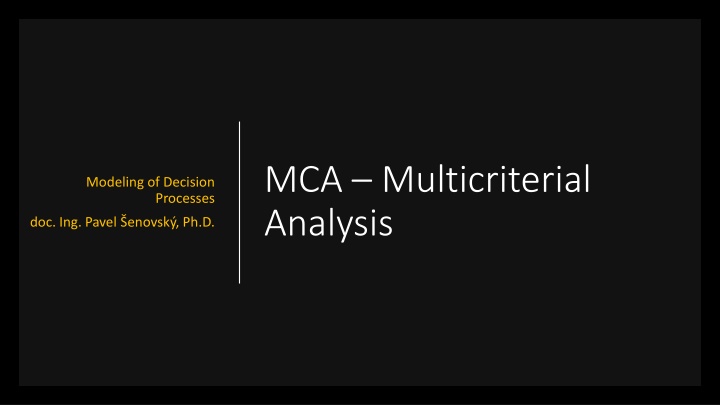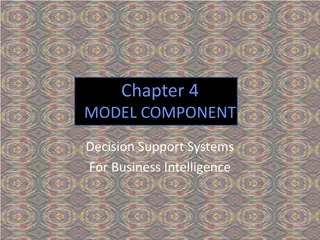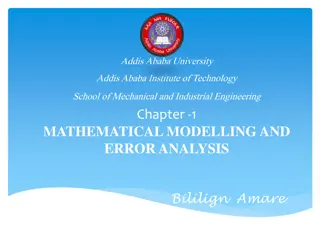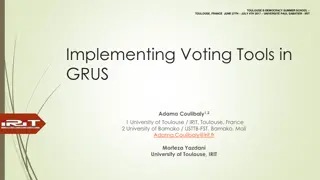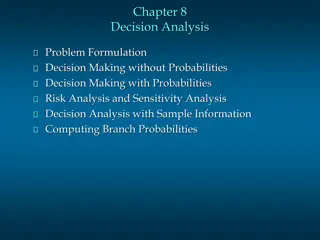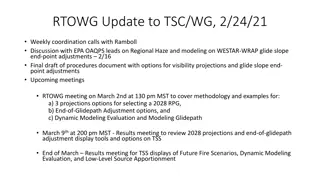Multicriterial Analysis in Decision Processes Modeling
This document discusses the concept of Multicriterial Analysis (MCA) in decision-making processes, highlighting its importance in addressing multi-criteria decision challenges. MCA involves comparing various methods like Electre, Promethee, and Topsis to support decision-making by evaluating utility and risks associated with choices.
Download Presentation

Please find below an Image/Link to download the presentation.
The content on the website is provided AS IS for your information and personal use only. It may not be sold, licensed, or shared on other websites without obtaining consent from the author.If you encounter any issues during the download, it is possible that the publisher has removed the file from their server.
You are allowed to download the files provided on this website for personal or commercial use, subject to the condition that they are used lawfully. All files are the property of their respective owners.
The content on the website is provided AS IS for your information and personal use only. It may not be sold, licensed, or shared on other websites without obtaining consent from the author.
E N D
Presentation Transcript
MCA Multicriterial Analysis Modeling of Decision Processes doc. Ing. Pavel enovsk , Ph.D.
MCA Sometimes one criterion is not enough Decision trees can work with multiple criteria, but it is not elegant Tree for every single criterion needs to be computed Then it is required to aggregate them Existence of various connected problems as Different units Existence of bias Necessity to work with both utility and risks connected to choice MCA is one of methods addressing such issues
MCA Multiple methods are being used in the praxis The MCA we are talking today supports the decision by comparing the distance to optimum Many methods work like that: Electre (I, II, III, ) Promethee Topsis Lecture demonstrates principles these are based on There are decision support packages implementing these methods (and many others)
Statement of the problem MCA - outline Analytic information Information gathering Thematic information Utility evaluation Works well in general outline of the problem solution we established in previous lecture for decision trees Risk evaluation Final evaluation Formulation of recomendations
Criteria in their natural units Variants are labeled neutrally as V1 Vn Direct comparison of criteria not possible (comparing apples and pears) Utility Utility evaluation evaluation 1. quantifying criteria
2. Table of simple utility Generally: we need to normalize the criteria I. e. criteria value as % of utility 0 = no utility 100 = max. utility The transformation from natural units may be linear or more complicated i.e. size of display for mobile phone bigger = better up to certain size Transformation process must be documented!
Other normalization methods Method name Min-max Maximize criterion ? min ? max ? min ? ? =? ? 100 ? max ? Minimize criterion ? min ? max ? min ? ? = ? = 1 Compare with average Compare with leader ? = 100 ln ??? ln( ?=1 ln ??? ln( ?=1 ? 1 Logarithmic normalization 1 ???= ????) ????) ???= ? min(?) max ? min(?) 100 ? min ? max ? min ? POMP ???? = ???? = 1 100 ??? 1 Vector normalization ???= ??? ? 2 ???= ?=1 ?? 1 ?? ? ?=1 2 ??? ???? 1/??? ?=1 Linear normalization by aggregating the values ???= ???= ?=1 ?1/???
Normalization You can choose even arbitrary created set of transformational rules Regardless of what you choose you need to be capable to defend it Examples of usage:
Are all criteria independent or do the form hierarchy (or network)? MCA in lecture expects independent criteria If it is not the case we have to perform analysis in different way Use for example: AHP Analytic Hierarchy Process ANP Analytic Network Process (superdecisions.com) Comparing the criteria
Deriving the weights of the criteria Different criteria contribute differently to decision Need to establish weight for criteria There are lots of methods We focus on pairwise comparison Fuller triangle Binary comparison Compare every pair of criteria and add a point to preferred one No. of preferences will lead to establishment of order based on their importance
Alternative approach using Fullers triangle Compare criteria Criterion Order Weight Count
Alternative methods to establish weight system Directly state order of the criteria Direct valuing of the criteria importance using points Budget allocation method Derive weights from allocated points ?? ??= ? ?=1 ?? Where p = points, w = weights
3. Table of weighted criteria Weighted criteria are comparable and also consider different contribution of criteria to decision Added column M for theoretical maximal utility variant M will be considered = 100% Variants will be compared to it First results of our analysis Please note, that if weights have been normalized (as described by equation on previous slide), neither M or U needs to be computed and SUM of the weighted criteria, for the variant is the Utility sufficient enough to establish order of the variants.
Risk evaluation table of risks Similar to working with utility Value of risk is already in % Be careful to what time period is risk connected 3% per year <> 3% per decade (3x per 100 years vs 3x per 1000 years) It needs to be scaled to same time period
Weighted risks Risk are also weighted R = Probability * Consequence Probability is already established Weights will represent the consequence part of risk Again Vmax is computed Other variants are compared to it
Final effect Utility vs risks Utility risks Utility / risks May lead to different order of the variants Strategies Maximal maximize utility Minimal minimize risks Optimal use final effect Possible to form alternatives to recomendations
Example choosing e-book reader Statement of the problem: Recomend e-Ink e-book reader, for the reading of beletry. E-books will be in e- book formate (either epub or mobi), the usage of PDF format is not required and we do presume, that the PDF format will not be used for reading on the device. Analytic information Display size (5, 6, 9.7 in) Display type Peal/Carta Wi-fi Support for mobi/epub SD card support Thematic information Use tablet or large mobile phone Paper books rule supreme
Identified Variants for E-Ink E-book Reader V1 Kobo Glo V2 - Sony Reader PRS-T3 V3 - Amazon Kindle Paperwhite 2 V4 - Pocketbook Touch Lux V5 - Bookeen Cybook Odyssey HD FrontLight
Variants V1 - Kobo Glo V2 - Sony Reader PRS-T3 V3 - Kindle Paperwhite 2 V4 - Pocketbook Touch Lux V5 - Bookeen Cybook Odyssey HD FrontLight
Criteria in natural units Criteria Units V1 V2 V3 V4 V5 K1 Display - Pearl Pearl Carta Pearl Pearl K2 Weight g 185 200 206 198 180 K3 touch UI Y/N Y Y Y Y Y K4 HW buttons Y/N N Y N Y Y K5 front light Y/N Y N Y Y Y K6 battery No. page turns 2100 1700 1700 1700 1900 K7 wi-fi Y/N Y Y Y Y Y K8 price K 3400 3800 3300 3400 4200
Criteria utility Criteria V1 V2 V3 V4 V5 K1 Display 80 80 100 80 80 K2 Weight 97 88 85 90 100 K4 HW buttons 50 100 50 100 100 K5 front light 100 20 100 100 100 K6 battery 100 70 70 70 85 K8 price 94 70 100 94 50
Pairwise comparison criteria Freq. Order Weight K1 Display 4 1 5 K2 Weight 2 3 3 K4 HW buttons 3 2 4 K5 front light 4 1 5 K6 battery 1 4 2 K8 price 0 5 1
Weighted utility Criteria Weight V1 V2 V3 V4 V5 M K1 Display 5 400 400 500 400 400 500 K2 Weight K4 HW buttons K5 front light 5 3 291 264 255 270 300 300 4 200 400 200 400 400 400 500 100 500 500 500 500 K6 battery 2 200 140 140 140 170 200 K8 price 1 94 70 100 94 50 100 SUM 1685 1374 1695 1804 1820 2000 Utility % 84,25 68,7 84,75 90,2 91 100
Risks establishment and pairwise comparison Risks V1 V2 V3 V4 V5 R1 40 30 5 10 10 R2 30 30 5 40 10 R3 40 40 0 30 40 R1 - Premature end of support for the device by producer R2 - Denying complaint for broken screen R3 - End of life of the book e-shop integrated into the reader
Risk establishing weights Risks Freq. Order Weight R1 0 3 1 R2 2 1 3 R3 1 2 2
Table of weighted risks Risks Weig ht V1 V2 V3 V4 V5 Vmax p GT p GT p GT p GT p GT p GT R1 1 0,4 0,4 0,3 0,3 0,05 0,05 0,1 0,1 0,1 0,1 1 1 R2 3 0,3 0,9 0,3 0,9 0,05 0,05 0,4 1,2 0,1 0,3 1 3 R3 2 0,4 0,8 0,4 0,8 0 0 0,3 0,6 0,4 1,2 1 2 SUM 2,1 2 0,1 1,9 1,6 6 GT % 35 33,3 1,7 31,7 26,7 100
Final Effect V1 V2 V3 V4 V5 Utility 84,25 68,7 84,75 90,2 91 Risks 35 33,3 1,7 31,7 26,7 U - R 49,25 35,4 83,05 58,5 64,3 U/R 2,4 2,1 49,9 2,8 3,4
